Publication
Article
Psychiatric Times
Depression and Comorbid Anxiety: An Overview of Pharmacological Options
Although depressive and anxiety disorders are classified as distinct groups of illnesses, studies document their frequent co-occurrence and provide evidence of a common biological substrate and a shared vulnerability.
Psychiatric Times - Category 1 Credit (Expired)
This article was originally presented as an independent educational activity under the direction of CME LLC. The ability to receive CME credits has expired. The article is now presented here for your reference.
Educational Objectives
After reading this article, you will be familiar with:
• Ways to recognize and assess comorbid depression and anxiety
• Pharmacological treatment approaches
• Treatment for comorbidity of depression and specific anxiety disorders
Who will benefit from reading this article?
Psychiatrists, psychologists, primary care physicians, nurse practitioners, and other health care professionals. To determine whether this article meets the continuing education requirements of your specialty, please contact your state licensing and certification boards.
Although depressive and anxiety disorders are classified as distinct groups of illnesses, studies document their frequent co-occurrence and provide evidence of a common biological substrate and a shared vulnerability.1 Comorbid depression and anxiety disorders are most frequently seen in primary care and in the general community, and the prevalence of comorbidity has been estimated to be as high as 10% to 20%.1 The comorbidity of depression and anxiety tends to have an earlier age of onset, increased severity of illness, more functional impairment, and poorer outcome (including greater risk of suicide) than does depression or anxiety alone.2 Research data and clinical experience suggest that depression comorbid with anxiety disorders may show less robust response to both pharmacotherapy and psychosocial interventions and may lead to more residual symptoms and increased vulnerability to relapse.3,4
General guidelines
Early recognition is an important first step in the management of depression with comorbid anxiety. Co-occurrence may take several forms. Depression may be present comorbidly with one or more anxiety disorders. Alternatively, the depression may be primary, with significant anxiety symptoms that do not meet criteria for a disorder (subsyndromal anxiety). Many patients may also present with an equal admixture of depressive and anxiety symptoms, neither of which meets criteria for full disorders (mixed depression-anxiety). Thus, the assessment of patients with depression should explore the presence of subsyndromal anxiety symptoms and mixed depression-anxiety, as well as specific anxiety disorders.
Several easy-to-use self-rated scales are available for monitoring symptoms:
• Depression Anxiety Stress Scale (42-item or shorter 21-item)
• Beck Depression Inventory
• Beck Anxiety Inventory
• Yale-Brown Obsessive Compulsive Scale
The onset and temporal course (episodic vs continuous) of depressive and anxiety symptoms and the influence of stressors on these factors help formulate the diagnosis and plan the management. The cost and availability of treatments, illness severity, presence of comorbid medical conditions, and past/family history of response to a particular treatment will also influence the choice of pharmacotherapy. In addition, an inquiry into the patient’s functional state and assessment of disabilities is useful in monitoring improvement and progress. (Table 1 provides clinical tips for treating comorbid depression and anxiety disorder.)
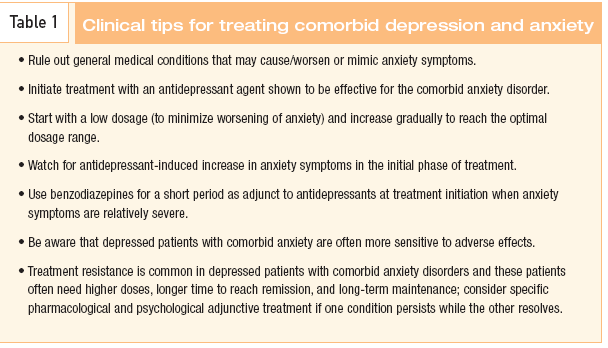
After evaluation, an appropriate explanation of the comorbid condition to patients is vital. Patients are often given information on depression that pertains only to its classic presentation, with no consideration of the anxiety component, which is often more troublesome to the patient. Information on the complexity of the depression-anxiety presentation and the need for effective treatment can significantly improve adherence.
In addition to pharmacotherapy, psychological (specifically, cognitive-behavioral therapy) and social interventions should form an important component of the overall management. However, only pharmacological options are discussed in this review.
Psychopharmacology
Many psychotropic agents have been investigated for the treatment of individual depressive and anxiety disorders. However, specific trials in depression with comorbid anxiety disorders are limited. While antidepressants, particularly SSRIs and serotonin norepinephrine reuptake inhibitors (SNRIs), form the bulk of the recent treatment literature, there is increasing evidence of the benefit of atypical antipsychotics, anticonvulsants, and benzodiazepines in optimizing treatment response.
SSRIs and SNRIs. SSRIs, which include fluoxetine, fluvoxamine, sertraline, paroxetine, citalopram, and escitalopram, have a proven history of efficacy in the treatment of patients with discrete depressive and anxiety disorders. In general, this class of agents appears to be effective in treating depression with comorbid anxiety disorders.3 SSRIs are generally well tolerated, although they do have potentially troublesome adverse effects, such as sexual dysfunction and agitation, as well as GI effects.
SNRIs include venlafaxine, duloxetine and, more recently, desvenlafaxine. There is some evidence that remission rates may be higher with venlafaxine than with SSRIs.4 Furthermore, higher than normal doses of venlafaxine may have an advantage for patients with refractory depression, who often have comorbid anxiety disorders.5 No efficacy advantage for duloxetine or desvenlafaxine over SSRIs has been reported; this is probably because of their relatively recent introduction to the psychiatric pharmacopeia. A suggested schedule for treatment with antidepressants is given in Table 2.
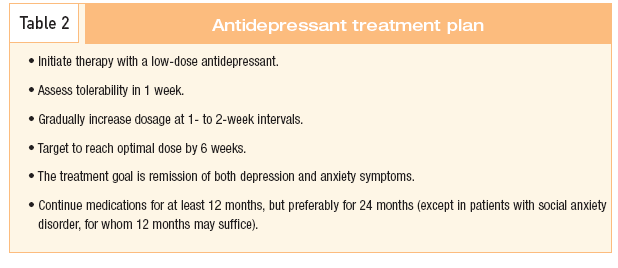
Tricyclic antidepressants, monoamine oxidase inhibitors, reversible inhibitors of monoamine oxidase. These classes of antidepressants are effective for depressive disorders but tend to have a greater burden of adverse effects than the current first-line agents. Potential sequelae include risk of toxicity with overdose of tricyclic antidepressants (TCAs), dietary restrictions with monoamine oxidase inhibitors (MAOIs), and a greater likelihood of drug-drug interactions with both classes of agents.6 Several TCAs, such as clomipramine and imipramine, have been shown to be effective in anxiety disorders and in depression comorbid with anxiety disorders.7,8 Similarly, MAOIs (eg, phenelzine) and reversible inhibitors of monoamine oxidase (RIMAs), eg, moclobemide, have shown efficacy in depressive disorders and in anxiety syndromes-particularly social anxiety disorder (SAD) and posttraumatic stress disorder (PTSD)-although RIMAs are not currently available in the United States.9
Other novel antidepressants. Bupropion, a norepinephrine dopamine reuptake inhibitor, has a different adverse-event profile from SSRIs. Meta-analyses confirm that its efficacy is equal to that of SSRIs in depressive disorders and even for anxiety symptoms associated with depression, although similar benefits were not seen in primary anxiety syndromes.10-12
Mirtazapine, a noradrenergic and selective serotonin antidepressant, is said to be particularly effective in severe depression, with comparable efficacy to TCAs and the advantage of enhancing sleep and appetite.13 There is evidence of its benefit in depression comorbid with anxiety disorders, as well as with specific anxiety syndromes.14,15
Buspirone, a serotonin1A partial agonist, has been approved for treatment of generalized anxiety disorder (GAD), but it may also be useful in depression with subsyndromal anxiety symptoms or as an adjunctive treatment for depression.16,17 Generally well tolerated, the most commonly reported adverse effects include dizziness, head- ache, nervousness, nausea, and restlessness. One disadvantage of buspirone is the 2- to 4-week lag before improvement.
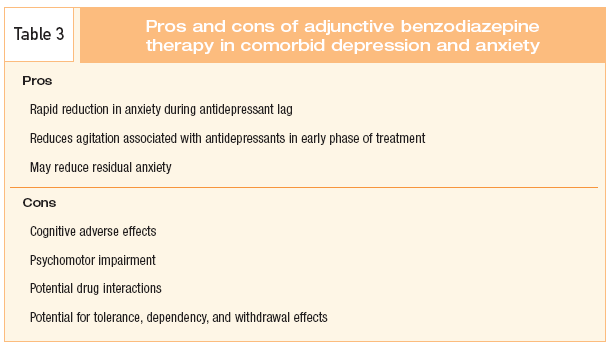
Antipsychotics. Although typical antipsychotics, such as haloperidol, pimozide, and loxapine, have shown a degree of efficacy as adjunctive agents in the treatment of depression and anxiety, the burden of adverse effects and possible propensity to worsen depression have limited their use.18 Atypical antipsychotics (including olanzapine, risperidone, quetiapine, aripiprazole, and ziprasidone) have been increasingly used to treat depressive and anxiety disorders, mostly as adjunctive agents in patients with refractory symptoms.19 Evidence for the use of atypical antipsychotics as monotherapy in unipolar depression is limited, with the exception of quetiapine, which has recently had positive outcomes in both unipolar and bipolar depression, and has shown benefits for depression with comorbid anxiety disorders.20,21
Benzodiazepines. These agents are helpful in anxiety disorders because of their rapid onset of action and generally good adverse-effect profile, which result in high patient acceptance and adherence; however, as with all psychotropics, the benefit to risk ratio must be considered (Table 3).22 However, common adverse effects include sedation, cognitive impairment, development of tolerance and dependence, and rebound anxiety on discontinuation. The risk of dependency, in particular, has led to cautious use of these agents, which are generally recommended for short-term use.
While there is some evidence that benzodiazepine monotherapy may improve milder forms of depression, such treatment is unlikely to benefit patients with severe melancholic forms and, in some patients, may worsen depression.23,24 Nevertheless, when used as an adjunct to antidepressants for depression with comorbid anxiety disorders, benzodiazepines may have several benefits. They may diminish the initial worsening of agitation and anxiety seen in the early phases of antidepressant treatment (thereby improving adherence), and they may also produce more rapid improvement of both anxiety and depressive symptoms than antidepressants alone.25
Anticonvulsants. Several anticonvulsants have been evaluated for their efficacy as monotherapy or adjunctive treatment in individual depressive and anxiety disorders but not in depression with comorbid anxiety disorders. Currently, the greatest evidence exists for valproate and lamotrigine, but specifically for bipolar depression, although there is early evidence of their benefit for panic disorder (PD), SAD, and PTSD.26,27 In contrast, gabapentin, pregabalin, and topiramate were found to help with these same anxiety disorders but were not shown to be effective as monotherapy for depression.27
More recent preliminary findings indicate some benefits from pregabalin and tiagabine in GAD, with tiagabine monotherapy showing efficacy in major depressive disorder with anxious features.25,28
Treatment for specific comorbidities
Although almost all classes of antidepressants display some degree of efficacy in the treatment of depression with comorbid anxiety disorders, the evidence varies across the agents and type of anxiety disorder. Even more importantly, there are few randomized controlled trials (RCTs) of specific agents in depression with particular anxiety comorbidities. Thus, the evidence presented below is mostly based on the data from trials of these agents for specific anxiety disorders (Table 4).
Of the few studies on depression with comorbid GAD, benefits have been found with escitalopram and venlafaxine.29,30 As such, these may be considered first-line treatment.29,30 Several SSRIs and SNRIs have also shown strong efficacy in GAD alone. Venlafaxine has been found to have particular benefits for psychic anxiety (the ruminative worry associated with GAD).31 Preliminary evidence also exists for imipramine, bupropion, buspirone, pregabalin, and tiagabine in GAD, as well as for atypical antipsychotics or mirtaza- pine.19,21,32-37 While benzodiazepines may afford quick relief of anxiety symptoms, such benefit may wear off after a few weeks of treatment and may not relieve depression.23,31
Most patients with comorbid depression and GAD of mild to moderate severity may be treated with SSRI or SNRI monotherapy. Those who have severe forms may benefit from augmentation with benzodiazepines, atypical antipsychotics, or anticonvulsants.
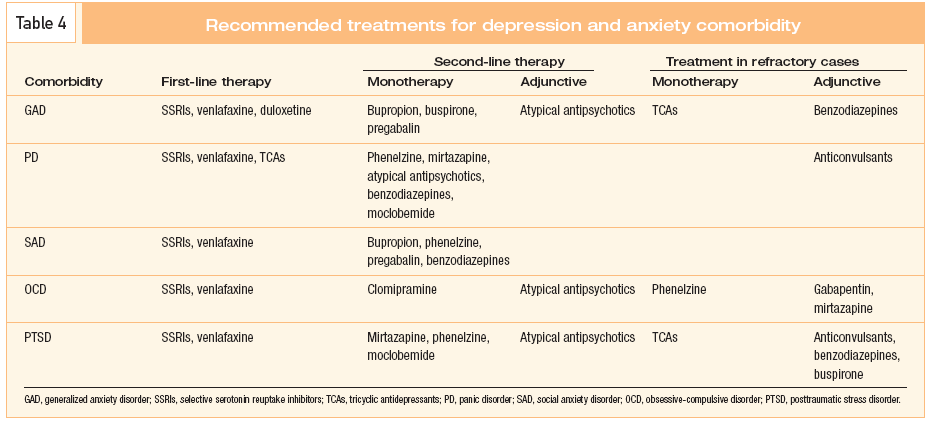
Reports from RCTs in depression and comorbid PD are sparse, but there is robust evidence that antidepressants have significant benefit in PD alone. Specifically, evidence supports the use of all SSRIs, venlafaxine, and TCAs in PD.38,39 In addition, mirtazapine and adjunctive atypical antipsychotics may also improve panic and agoraphobic symptoms.23,40
As noted, benzodiazepines have no proven efficacy in moderate to severe depression; however, they have shown benefit in PD.41 In particular, clonazepam adjunctive to SSRI initiation can speed onset of response.42 Limited benefits for monotherapy with phenelzine, moclobemide, and divalproex have been noted.9,43,44 The efficacy of these antidepressant agents in PD alone suggests that they may also be useful in depression comorbid with PD. For most patients, initiation of treatment with SSRIs or SNRIs, in conjunction with clonazepam followed by a slow taper of the benzodiazepine after remission, appears to be effective.
There are no published RCTs of psychopharmacological agents specifically for comorbid depression and SAD. However, as in depression, SSRIs and venlafaxine have shown significant benefits in treating SAD alone, both in the short and long term.45 Notably, a longer duration of treatment with SSRIs or SNRIs (ie, 6 months to 2 years) has been shown to produce greater and more sustained treatment response in SAD, which is likely to be even more applicable in those with depressive comorbidity.46
Other antidepressants that have shown some efficacy in SAD alone include bupropion and phenelzine.47,48 There is also sufficient evidence for benzodiazepines and anticonvulsants as second-line treatments.49,50 Evidence for mirtazapine and atypical antipsychotics in SAD is still limited, making them third-line alternatives, and while moclobemide has shown efficacy in depression, it has had mixed results for SAD.51-54 For most patients with depression and SAD, monotherapy with SSRIs and SNRIs may produce remission; the augmentation strategies may be more beneficial in refractory cases.
There are no published studies of depression comorbid with specific phobias. The literature on the pharmacological treatment of specific phobias alone is also sparse, probably because patients with phobic symptoms respond well to cognitive-behavioral therapy.55 Most available data are on the efficacy of SSRI monotherapy.56 No benefit was noted for benzodiazepine augmentation of exposure therapy.55 If significant phobic symptoms remain after remission of depression, the addition of cognitive-behavioral interventions appears to be the best option.
Unfortunately, most treatment studies of obsessive-compulsive disorder (OCD) use the significant presence of depression as an exclusion criterion. Thus, there are few reports of the efficacy of pharmacological agents in depression with comorbid OCD. In OCD alone, the most robust evidence is for the efficacy of SSRIs as a class together with clomipramine and, secondarily, venlafaxine.57,58 In refractory cases, mirtazapine may be useful as monotherapy, with MAOIs, adjunctive typical and atypical antipsychotics, and adjunctive anticonvulsants as other possible options.11,59-63
For patients with depression and comorbid OCD, treatment often begins with an SSRI. Some advantage has been suggested for sertraline and fluvoxamine. The dosage is gradually increased based on tolerability. Clinicians should also expect an extended treatment period (6 to 12 months or more) with the likelihood of maintenance treatment for many patients.64
Combination of SSRIs or clomipramine with atypical antipsychotics (eg, risperidone) is a common strategy for treatment-resistant patients. Comorbid OCD and bipolar disorder is particular- ly hard to treat because maintenance with anti- obsessive agents is needed for OCD, which may make patients vulnerable to manic switches, thus necessitating antimanic prophylaxis.65
PTSD is often comorbid with depression, other anxiety disorders, personality disorders, and/or substance abuse, which makes treatment a challenge.66 As with most other anxiety disorders, there are no studies specifically on depression with comorbid PTSD, although many PTSD trials do permit inclusion of comorbid depression.
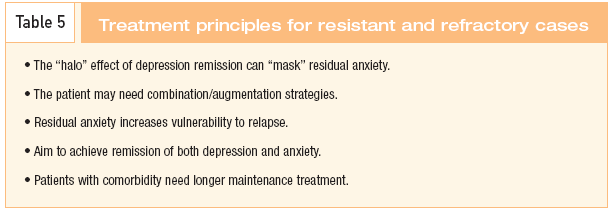
As such, several classes of antidepressants have shown efficacy for PTSD in the presence of significant depressive symptoms. Most evidence has been for SSRIs and venlafaxine.66 Mirtazapine, moclobemide, phenelzine, and adjunctive atypi-cal antipsychotics have reasonable evidence to support their benefit.19,66-68 When symptoms are refractory, TCAs, adjunctive anticonvulsants (particularly for psychotic PTSD symptoms), buspirone, and the opioid receptor antagonist, naltrexone, could be considered.66,69,70 Monotherapy with benzodiazepines has not been found to be of benefit in PTSD, but these agents may be useful when combined with SSRIs.66
Treatment of depression and comorbid PTSD should be long-term because of the likelihood of relapse with early discontinuation.71 Delayed onset of improvement and lag in improvement in psychosocial functioning further support longer maintenance treatment.71
Conclusion
Comorbid depressive and anxiety disorders are commonly seen in both primary care and the specialty setting. Such comorbidity can present as major depression with subsyndromal anxiety symptoms or unipolar/bipolar depression comorbid with an anxiety disorder. Those patients with depression and comorbid anxiety appear to have a significantly greater illness burden, worse response, and a more chronic course of illness than patients with depression alone. While most antidepressants have been shown to have significant anxiolytic properties, there are few systematic investigations of their benefit in depression with comorbid anxiety disorders. Support for their use comes largely from studies of non-comorbid populations with primary anxiety. Overall, SSRIs and SNRIs continue to remain the first-line agents for the treatment of depression comorbid with anxiety disorders. Short-term benzodiazepine augmentation may help many patients, and there is preliminary evidence for the benefit of atypical antipsychotics as well as certain anticonvulsants.
In resistant and refractory cases, augmentation and combination strategies with these agents may be warranted. Should one condition remit and the other persist, specific interventions for the residual condition should be considered; affected patients often need longer maintenance treatment (Table 5). Both the literature and clinical experience suggest that a combination of pharmacological and psychological forms of treatment is ideal. Remission of both clinical syndromes should be the goal.
References:
Drugs Mentioned in This Article
Aripiprazole (Abilify)
Bupropion (Wellbutrin, Zyban)
Buspirone (BuSpar)
Citalopram (Celexa)
Clomipramine (Anafranil)
Clonazepam (Klonopin)
Desvenlafaxine (Pristiq)
Divalproex (Depakote)
Duloxetine (Cymbalta)
Escitalopram (Lexapro)
Fluoxetine (Prozac, Sarafem, Symbyax)
Fluvoxamine (Luvox)
Gabapentin (Neurontin)
Haloperidol (Haldol)
Imipramine (Tofranil)
Lamotrigine (Lamictal)
Loxapine (Loxitane, others)
Mirtazapine (Remeron)
Moclobemide (Manerix)
Naltrexone (Depade, Revia)
Olanzapine (Zyprexa)
Paroxetine (Paxil)
Phenelzine (Nardil)
Pimozide (Orap)
Pregabalin (Lyrica)
Quetiapine (Seroquel)
Risperidone (Risperdal)
Sertraline (Zoloft)
Tiagabine (Gabitril)
Topiramate (Topamax)
Valproate/valproic acid (Depakote, others)
Venlafaxine (Effexor)
Ziprasidone (Geodon)
Â
References
1. Lepine JP, Wittchen HU, Essau CA. Lifetime and current comorbidity of anxiety and affective disorders: results from the International WHO/ADHAMA CIDI field trials. Int J Methods Psychiatr Res. 1993;3:67-77.
2. Coryell W, Endicott J, Andreasen NC, et al. Depression and panic attacks: the significance of overlap as reflected in follow-up and family study data. Am J Psychiatry. 1988;145:293-300.
3. Hirschfeld RM. The comorbidity of major depression and anxiety disorders: recognition and management in primary care. Prim Care Companion J Clin Psychiatry. 2001;3:244-254.
4. Hranov LG. Comorbid anxiety and depression: illumination of a controversy. Int J Psychiatry Clin Prac. 2007;11:171-189.
5. Thase ME, Shelton RC, Khan A. Treatment with venlafaxine extended release after SSRI nonresponse or intolerance: a randomized comparison of standard- and higher-dosing strategies. J Clin Psychopharmacol. 2006;26:250-258.
6. Rapaport MH. Dietary restrictions and drug interactions with monoamine oxidase inhibitors: the state of the art. J Clin Psychiatry. 2007;68(suppl 8):42-46.
7. Zohar J, Westenberg HG. Anxiety disorders: a review of tricyclic antidepressants and selective serotonin reuptake inhibitors. Acta Psychiatr Scand Suppl. 2000;403:39-49.
8. Tollefson GD, Holman SL, Sayler ME, Potvin JH. Fluoxetine, placebo, and tricyclic antidepressants in major depression with and without anxious features. J Clin Psychiatry. 1994;55:50-59.
9. Bandelow B, Zohar J, Hollander E, et al. World Federation of Societies of Biological Psychiatry (WFSBP) guidelines for the pharmacological treatment of anxiety, obsessive-compulsive and post-traumatic stress disorders-first revision. World J Biol Psychiatry. 2008;9:248-312.
10. Thase ME, Haight BR, Richard N, et al. Remission rates following antidepressant therapy with bupropion or selective serotonin reuptake inhibitors: a meta-analysis of original data from 7 randomized controlled trials. J Clin Psychiatry. 2005;66:974-981.
11. Papakostas GI, Trivedi MH, Alpert JE, et al. Efficacy of bupropion and the selective serotonin reuptake inhibitors in the treatment of anxiety symptoms in major depressive disorder: a meta-analysis of individual patient data from 10 double-blind, randomized clinical trials. J Psychiatr Res. 2008;42:134-140.
12. Becker ME, Hertzberg MA, Moore SD, et al. A placebo-controlled trial of bupropion SR in the treatment of chronic posttraumatic stress disorder. J Clin Psychopharmacol. 2007;27:193-197.
13. Fava M, Rush AJ, Wisniewski SR, et al. A comparison of mirtaza-
pine and nortriptyline following two consecutive failed medication treatments for depressed outpatients: a STAR*D report. Am J Psychiatry. 2006;163:1161-1172.
14. Pollack MH, Marzol PC. Pharmacotherapeutic options in the treatment of comorbid depression and anxiety. CNS Spectr. 2000;5:23-30.
15. Sarchiapone M, Amore M, De Risio S, et al. Mirtazapine in the treatment of panic disorder: an open-label trial. Int Clin Psychopharmacol. 2003;18:35-38.
16. Chessick CA, Allen MH, Thase M, et al. Azapirones for generalized anxiety disorder. Cochrane Database Syst Rev. 2006;3:CD006115.
17. Fava M, Rush AJ, Alpert JE, et al. Difference in treatment outcome in outpatients with anxious versus nonanxious depression: a STAR*D report. Am J Psychiatry. 2008;165:342-351.
18. Gao K, Gajwani P, Elhaj O, Calabrese JR. Typical and atypical antipsychotics in bipolar depression. J Clin Psychiatry. 2005;66:1376-1385.
19. Gao K, Muzina D, Gajwani P, Calabrese JR. Efficacy of typical and atypical antipsychotics for primary and comorbid anxiety symptoms or disorders: a review. J Clin Psychiatry. 2006;67:1327-1340.
20. Weisler RH, Calabrese JR, Thase ME, et al. Efficacy of quetiapine monotherapy for the treatment of depressive episodes in bipolar I disorder: a post hoc analysis of combined results from 2 double-blind, randomized, placebo-controlled studies. J Clin Psychiatry. 2008;69:769-782.
21. Galynker I, Khan A, Grebchenko Y, et al. Low-dose risperidone and quetiapine as monotherapy for comorbid anxiety and depression. J Clin Psychiatry. 2005;66:544.
22. Rosenbaum JF. Attitudes toward benzodiazepines over the years.
J Clin Psychiatry. 2005;66(suppl 2):4-8.
23. Birkenhäger TK, Moleman P, Nolen WA. Benzodiazepines for depression? A review of the literature. Int Clin Psychopharmacol. 1995;
10:181-195.
24. Feather LJ, Spraggins JK, Helsley JD. Anxiety disorders and comorbidities. In: Vanin JR, Helsley JD, eds. Anxiety Disorders: A Pocket Guide for Primary Care. New York: Humana Press; 2008:209-219.
25. Weisberg RB, Dyck I, Culpepper L, Keller MB. Psychiatric treatment in primary care patients with anxiety disorders: a comparison of care received from primary care providers and psychiatrists [published correction appears in Am J Psychiatry. 2007;164:833]. Am J Psychiatry. 2007;164:276-282.
26. Yatham LN, Kusumakar V, Calabrese JR, et al. Third generation anticonvulsants in bipolar disorder: a review of efficacy and summary of clinical recommendations. J Clin Psychiatry. 2002;63:275-283.
27. Mula M, Pini S, Cassano GB. The role of anticonvulsant drugs in anxiety disorders: a critical review of the evidence. J Clin Psychopharmacol. 2007;27:263-272.
28. Carpenter LL, Schecter JM, Tyrka AR, et al. Open-label tiagabine monotherapy for major depressive disorder with anxiety. J Clin Psychiatry. 2006;67:66-71.
29. Mohamed S, Osatuke K, Aslam M, Kasckow J. Escitalopram for comorbid depression and anxiety in elderly patients: a 12-week, open-label, flexible-dose, pilot trial. Am J Geriatr Pharmacother. 2006;4:201-209.
30. Perugi G, Frare F, Toni C, et al. Open-label evaluation of venlafaxine sustained release in outpatients with generalized anxiety disorder with comorbid major depression or dysthymia: effectiveness, tolerability and predictors of response. Neuropsychobiology. 2002;46:145-149.
31. Gorman J. Treatment of generalized anxiety disorder. J Clin Psychiatry. 2002;63(suppl 8):17-23.
32. Kapczinski F, Lima MS, Souza JS, Schmitt R. Antidepressants for generalized anxiety disorder. Cochrane Database Syst Rev. 2003;(2): CD003592.
33. Bystritsky A, Kerwin L, Eiduson S, et al. A pilot controlled trial
of bupropion vs. escitalopram in generalized anxiety disorder (GAD). Neuropsychopharmacology. 2005;30(suppl 1):S101.
34. Laakmann G, Schüle C, Lorkowski G, et al. Buspirone and lorazepam in the treatment of generalized anxiety disorder in outpatients. Psychopharmacology (Berl). 1998;136:357-366.
35. Rickels K, Pollack MH, Feltner DE, et al. Pregabalin for treatment of generalized anxiety disorder: a 4-week, multicenter, double-blind, placebo-controlled trial of pregabalin and alprazolam. Arch Gen Psychiatry. 2005;62:1022-1030.
36. Schaller JL, Thomas J, Rawlings D. Low-dose tiagabine effectiveness in anxiety disorders. MedGenMed. 2004;6:8.
37. Gambi F, De Berardis D, Campanella D, et al. Mirtazapine treatment of generalized anxiety disorder: a fixed dose, open label study. J Psychopharmacol. 2005;19:483-487.
38. Bakker A, van Balkom A, Spinhoven P. SSRIs vs TCAs in the treatment of panic disorder: a meta-analysis. Acta Psychiatr Scand. 2002;
106:163-167.
39. Bradwejn J, Ahokas A, Stein DJ, et al. Venlafaxine extended-release capsules in panic disorder: flexible-dose, double-blind, placebo-controlled study. Br J Psychiatry. 2005;187:352-359.
40. Hollifield M, Thompson PM, Ruiz JE, Uhlenhuth EH. Potential effectiveness and safety of olanzapine in refractory panic disorder. Depress Anxiety. 2005;21:33-40.
41. Noyes R Jr, Burrows GD, Reich JH, et al. Diazepam versus alprazolam for the treatment of panic disorder. J Clin Psychiatry. 1996;57:349-355.
42. Pollack MH, Simon NM, Worthington JJ, et al. Combined paroxetine and clonazepam treatment strategies compared to paroxetine monotherapy for panic disorder. J Psychopharmacol. 2003;17:276-282.
43. Loerch B, Graf-Morgenstern M, Hautzinger M, et al. Randomised placebo-controlled trial of moclobemide, cognitive-behavioural therapy and their combination in panic disorder with agoraphobia. Br J Psychiatry. 1999;174:205-212.
44. Baetz M, Bowen RC. Efficacy of divalproex sodium in patients with panic disorder and mood instability who have not responded to conventional therapy. Can J Psychiatry. 1998;43:73-77.
45. Baldwin DS, Anderson IM, Nutt DJ, et al; British Association for Psychopharmacology. Evidence-based guidelines for the pharmacological treatment of anxiety disorders: recommendations from the British Association for Psychopharmacology. J Psychopharmacol. 2005;19:567-596.
46. Lader M, Stender K, Bürger V, Nil R. Efficacy and tolerability of esci-
talopram in 12- and 24-week treatment of social anxiety disorder: randomised, double-blind, placebo-controlled, fixed-dose study. Depress Anxiety. 2004;19:241-248.
47. Emmanuel NP, Brawman-Mintzer O, Morton WA, et al. Bupropion-SR in treatment of social phobia. Depress Anxiety. 2000;12:111-113.
48. Heimberg RG, Liebowitz MR, Hope DA, et al. Cognitive behavioral group therapy vs phenelzine therapy for social phobia: 12-week outcome. Arch Gen Psychiatry. 1998;55:1133-1141.
49. Otto MW, Pollack MH, Gould RA, et al. A comparison of the efficacy of clonazepam and cognitive-behavioral group therapy for the treatment of social phobia. J Anxiety Disord. 2000;14:345-358.
50. Pande AC, Feltner DE, Jefferson JW, et al. Efficacy of the novel anxiolytic pregabalin in social anxiety disorder: a placebo-controlled, multicenter study. J Clin Psychopharmacol. 2004;24:141-149.
51. Van Veen JF, Van Vliet IM, Westenberg HG. Mirtazapine in social anxiety disorder: a pilot study. Int Clin Psychopharmacol. 2002;17:315-317.
52. Simon NM, Hoge EA, Fischmann D, et al. An open-label trial ofrisperidone augmentation for refractory anxiety disorders. J Clin Psychiatry.2006;67:381-385.53. Papakostas GI, Fava M. A metaanalysis of clinical trials comparingmoclobemide with selective serotonin reuptake inhibitors for the treatmentof major depressive disorder. Can J Psychiatry. 2006;51:783-790.
54. The International Multicenter Clinical Trial Group on Moclobemidein Social Phobia. Moclobemide in social phobia: a double-blind, placebo-controlled clinical study. Eur Arch Psychiatry Clin Neurosci. 1997;247:71-80.
55. Antony MM, Barlow DH. Specific phobias. In: Barlow DH, ed. Anxietyand Its Disorders: The Nature and Treatment of Anxiety and Panic.New York: Guilford Press; 2002.
56. Benjamin J, Ben-Zion IZ, Karbofsky E, Dannon P. Double-blind placebo-controlled pilot study of paroxetine for specific phobia. Psychopharmacology(Berl). 2000;149:194-196.
57. Ackerman DL, Greenland S. Multivariate meta-analysis of controlleddrug studies for obsessive-compulsive disorder. J Clin Psychopharmacol.2002;22:309-317.
58. Phelps NJ, Cates ME.The role of venlafaxine in the treatment of obsessive-compulsive disorder. Ann Pharmacother. 2005;39:136-140.
59. Koran LM, Gamel NN, Choung HW, et al. Mirtazapine for obsessivecompulsivedisorder: an open trial followed by double-blind discontinuation.J Clin Psychiatry. 2005;66:515-520.
60. Pallanti S, Quercioli L, Bruscoli M. Response acceleration with mirtazapineaugmentation of citalopram in obsessive-compulsive disorderpatients without comorbid depression: a pilot study. J Clin Psychiatry.2004;65:1394-1399.
61. Jenike MA, Baer L, Minichiello WE, et al. Placebo-controlled trial offluoxetine and phenelzine for obsessive-compulsive disorder. Am J Psychiatry.1997;154:1261-1264.
62. Keuneman RJ, Pokos V,Weerasundera R, Castle DJ. Antipsychotictreatment in obsessive-compulsive disorder: a literature review. AustN Z J Psychiatry. 2005;39:336-343.
63. Van Ameringen M, Mancini C, Patterson B, Bennett M. Topiramateaugmentation in treatment-resistant obsessive-compulsive disorder:a retrospective, open-label case series. Depress Anxiety. 2006;23:1-5.
64. Fineberg NA, Gale TM. Evidence-based pharmacotherapy of obsessive-compulsive disorder. Int J Neuropsychopharmacol. 2005;8:107-129.
65. Perugi G, Toni C, Frare F, et al. Obsessive-compulsive-bipolar comorbidity:a systematic exploration of clinical features and treatmentoutcome. J Clin Psychiatry. 2002;63:1129-1134.
66. Asnis GM, Kohn SR, Henderson M, Brown NL. SSRIs versus non-SSRIs in post-traumatic stress disorder: an update with recommendations.Drugs. 2004;64:383-404.
67. Davidson JR,Weisler RH, Butterfield MI, et al. Mirtazapine vs placeboin posttraumatic stress disorder: a pilot trial. Biol Psychiatry. 2003;53:188-191.
68. Neal LA, Shapland W, Fox C. An open trial of moclobemide in thetreatment of post-traumatic stress disorder. Int Clin Psychopharmacol.1997;12:231-237.
69. Berlin HA. Antiepileptic drugs for the treatment of post-traumaticstress disorder. Curr Psychiatry Rep. 2007;9:291-300.
70. Lubin G,Weizman A, Shmushkevitz M,Valevski A. Short-term treatmentof post-traumatic stress disorder with naltrexone: an open-labelpreliminary study. Hum Psychopharmacol. 2002;17:181-185.
71. Londborg PD, Hegel MT, Goldstein S, et al. Sertraline treatment ofposttraumatic stress disorder: results of 24 weeks of open-label continuationtreatment. J Clin Psychiatry. 2001;62:325-331.
Â
Evidence-Based ReferencesBandelow B, Zohar J, Hollander E, et al.World Federation of Societies ofBiological Psychiatry (WFSBP) guidelines for the pharmacological treatmentof anxiety, obsessive-compulsive and posttraumatic stress disorders-first revision.World J Biol Psychiatry. 2008;9:248-312.
Papakostas GI,Trivedi MH,Alpert JE, et al. Efficacy of bupropion and theselective serotonin reuptake inhibitors in the treatment of anxiety symptomsin major depressive disorder: a meta-analysis of individual patientdata from 10 double-blind, randomized clinical trials. J Psychiatr Res.2008;42:134-140.






